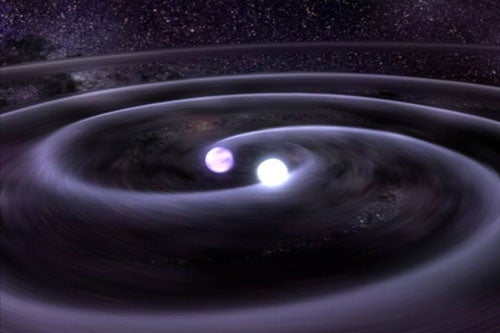Planetary scientists will get some unexpected help from the NASA/ESA Laser Interferometer Space Antenna (LISA) satellites thanks to a way of turning ‘noise’ from the mission’s data into useful information about near-Earth asteroids, according to a paper by Pasquale Tricarico, a scientist at the Tucson-based Planetary Science Institute.
LISA is on a mission to detect gravitational waves — a warping of the space/time continuum that scientists hope to see directly for the first time.
LISA, slated for launch no earlier than 2018, will include three satellites connected by laser beams. The distance between the satellites should change as a gravitational wave passes. But it’s a small effect, causing the distance to change by less than an atom’s width.
Einstein’s General Theory of Relativity predicts that gravitational waves from exploding stars or colliding black holes ripple across the universe, causing other bodies to wobble like driftwood in a motorboat’s wake.
In 2006, planetary scientists realized that near-Earth asteroids (NEAs) also would make the spacecraft wobble as they passed nearby, creating a distinct signature in the data being collected.
Tricarico expanded on that work to predict the number of asteroid encounters LISA can expect and how those encounters can be used to determine the mass of passing asteroids.
Tricarico’s paper predicts that LISA can expect to see one or two known near-Earth asteroids per year, and a total of around ten during the expected mission’s lifetime.
When an encounter with a known asteroid shows up in the data, scientists will already know its trajectory. “So from the signal, we can indirectly measure the asteroid’s mass because that’s the only uncertainty in the equation,” Tricarico said.
These mass measurements are important because “we only know the mass of asteroids that have been visited by spacecraft or the mass of a few binary asteroids observed from Earth,” he said. “We always wonder about the porosity, the density, and this will give us measurements from additional asteroids.”
If a known asteroid passes one of the satellites and doesn’t leave a signature, “that allows us to put an upper limit on the mass of that asteroid,” Tricarico said.
Tricarico also has predicted the number of potential encounters with smaller, unknown NEAs.
“We don’t have good constraints on the size distribution for small asteroids because they have to come very close to Earth for us to observe them using ground-based telescopes,” he said. If LISA starts detecting five asteroids per year instead of two or three, this could modify theories concerning the distribution of sizes in the NEA population.










